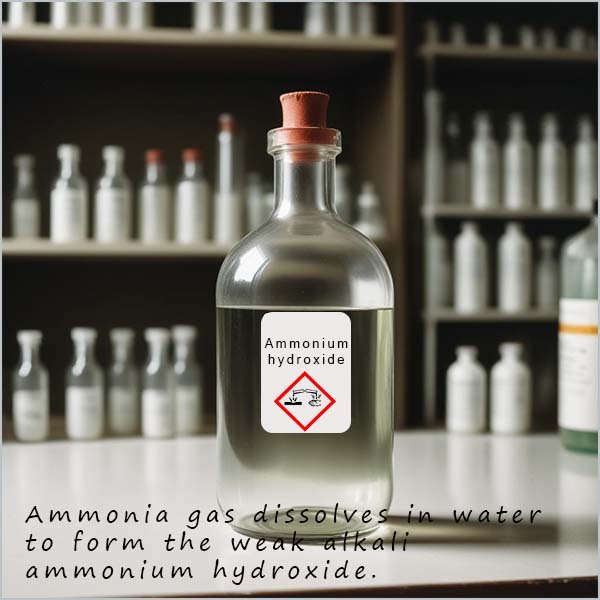Chemistry only
Making fertilisers
Many fertilisers contain ammonium ions (NH4+), for example ammonium nitrate, ammonium sulfate and
ammonium phosphate are three substances which can be found in many fertilisers. The starting point for making many of these fertilisers is ammonia (NH3).
Ammonia is an excellent base, now recall that a
base is a substance that will neutralise an acid and that all acids contain
hydrogen ions (H+) in their formula e.g.
| acid |
molecular formula |
| hydrochloric |
HCl |
| sulfuric |
H2SO4 |
| nitric |
HNO3 |
| phosphoric |
H3PO4 |

Ammonia being a base will "grab" hydrogen ions (H+) from many substances such as acids and water, for example
ammonia dissolves readily in water
to form an alkaline solution called ammonium hydroxide. The
ammonia here acts as a
base and removes a hydrogen ion from a
water molecule (H2O), leaving behind an ammonium ion (NH4+) and a hydroxide ion (OH-), an equation for this reaction is shown below:
ammonia(g) + water(l) ⇌ ammonium hydroxide(aq)
NH3(g) + H2O(l) ⇌ NH4OH(aq)


We can use the alkali ammonium hydroxide to react with and neutralise acids to produce the compounds found in fertilisers, for example the equations below show ammonium hydroxide reacting with hydrochloric (HCl), nitric (HNO3), sulfuric(H2SO4) and phosphoric(H3PO4) acids to produce the compounds ammonium chloride, ammonium sulfate, ammonium nitrate and ammonium phosphate. Now these four compounds can be mixed together in different ratios along with other compounds to produce many different types of fertilisers.
Now hydrochloric (HCl) and nitric acid (HNO3) only have one hydrogen atom in their chemical formula and these acids are often called monoprotic acids, while sulfuric acid (H2SO4) is a diprotic acid since it contains 2 hydrogen atoms in its chemical formula while phosphoric acid is a triprotic acid since it contains 3 hydrogen atoms in its chemical formula. If you study the equations carefully below you will see that hydrochloric and nitric acids being monoprotic acids will neutralise one mole of the alkali ammonium hydroxide, while the diprotic sulfuric acid will neutralise 2 moles of ammonium hydroxide and the triprotic acid phosphoric acid is capable of neutralising up to 3 moles of ammonium hydroxide solution.
1. Using hydrochloric acid to neutralise ammonium hydroxide
ammonium hydroxide(aq) + hydrochloric acid(aq) → ammonium chloride(aq) + water(l)
NH4OH(aq) + HCl(aq) → NH4Cl(aq) + H2O(aq)
2. Using nitric acid to neutralise ammonium hydroxide
ammonium hydroxide(aq) + nitric acid(aq) → ammonium nitrate(aq) + water(l)
NH4OH(aq) + HNO3(aq) → NH4NO3(aq) + H2O(aq)
3. Using sulfuric acid to neutralise ammonium hydroxide
ammonium hydroxide(aq) + sulfuric acid(aq) → ammonium sulfate(aq) + water(l)
2NH4OH(aq) + H2SO4(aq) → (NH4)2SO4(aq) + 2H2O(aq)
4. Using phosphoric acid to neutralise ammonium hydroxide
ammonium hydroxide(aq) + phosphoric acid(aq) → ammonium phosphate(aq) + water(l)
3NH4OH(aq) + H3PO4(aq) → (NH4)3PO4(aq) + 3H2O(aq)
In the above example 3 moles of
ammonium hydroxide
react with 1 mole of phosphoric acid. Since the reaction is a neutralisation reaction if we remove the spectator
ions, that is the ions that remain unchanged during the reaction then essentially all that is reacting is the hydroxide (OH-) ions in the alkali ammonium hydroxide
with the hydrogen ions (H+) ions in the phosphoric acid (H3PO4), we can show this neutralise reaction simply as:
3OH-(aq) + 3H+(aq) → 3H2O(l)
All the other ions remain unchanged in the reaction so are simply there to make up the numbers! They take no part in any
reaction - they are spectators! Since the phosphoric acid has 3 hydrogen ions (H+) it will require 3
hydroxide ions (OH-) to neutralise
them. However if only 1 or 2 moles of ammonium hydroxide are added then the acid will only be partially neutralised. In the equation below only
1 mole of ammonium hydroxide is added, this means it can only react with one of the three hydrogen ions (H+) in the phosphoric acid:
NH4OH(aq) + H3PO4(aq) → (NH4)H2PO4(aq) + H2O(aq)
Or if we add 2 moles of ammonium hydroxide, then it will react with 2 of the hydrogen ions (H+) present ions in the phosphoric acid, this is shown in the equation below:
2NH4OH(aq) + H3PO4(aq) → (NH4)HPO4(aq) + 2H2O(aq)
All of these compounds produced in the neutralisation reactions above can be used as fertilisers.
Key points
- Fertilisers are made in acid-base neutralisation reactions.
- Hydrochloric acid will gives salts called chloride.
Hydrochloric acid in a monoprotic acid, it contains only one acidic
hydrogen ion (H+).
- Nitric acid will gives salts called nitrate.
Nitric acid in a monoprotic acid, it contains only one acidic
hydrogen ion (H+).
- sulfuric acid will gives salts called sulfate. Sulfuric acid is a diprotic acid, this means it has
two acidic
hydrogen ions (H+).
- Phosphoric acid will gives salts called phosphates or hydrogen phosphates.
Phosphoric acid is a triprotic acid, this means
it has three acidic
hydrogen ions (H+).
Practice questions
Next




